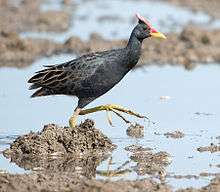Watercock
The watercock (Gallicrex cinerea) is a waterbird in the rail and crake family, Rallidae. It is the only member of the genus Gallicrex. Traditionally held to be closely related to moorhens (which the adult male visually closely resembles), it is actually member of a mostly tropical Asian clade containing also Aenigmatolimnas, Amaurornis, Himantornis and Megacrex.[2]
.jpg)
| Watercock | |
|---|---|
 | |
| Male at Basai Wetlands, near Gurgaon, Haryana, India | |
| Scientific classification | |
| Kingdom: | Animalia |
| Phylum: | Chordata |
| Class: | Aves |
| Order: | Gruiformes |
| Family: | Rallidae |
| Genus: | Gallicrex Blyth, 1852 |
| Species: | G. cinerea |
| Binomial name | |
| Gallicrex cinerea (Gmelin, 1789) | |
Their breeding habitat is swamps across south Asia from India, Pakistan, and Sri Lanka to south China, Korea, Japan, Philippines and Indonesia. They nest in a dry location on the ground in marsh vegetation, laying 3-6 eggs. These large rails are mainly permanent residents throughout their range.
The body of this rail is flattened laterally to allow easier passage through the reeds or undergrowth. It has long toes and a short tail.
Adult male watercocks are 43 cm (17 in) long and weigh 476–650 g (1.049–1.433 lb).[3] They have mainly black-grey plumage with red legs, bill, extended frontal shield and horn. Young males are buff in colour, darkening as they mature. Their bill is yellow and their legs are green.
Female birds are smaller at 36 cm (14 in) and 298–434 g (10.5–15.3 oz).[3] They are dark brown above and paler below. the plumage is streaked and barred with darker markings. The bill is yellow and the legs are green. The downy chicks are black, as with all rails.
These birds probe with their bill in mud or shallow water, also picking up food by sight. They mainly eat insects and small fish and seeds. They forage on the ground.
Watercock are quite secretive, but are sometimes seen out in the open. They are noisy birds, especially at dawn and dusk, with a loud, gulping call.
Gallery
 Water Cock in flight
Water Cock in flight Water Cock- Back Side View
Water Cock- Back Side View
References
- BirdLife International (2012). "Gallicrex cinerea". IUCN Red List of Threatened Species. 2012. Retrieved 26 November 2013.CS1 maint: ref=harv (link)
- Garcia-R et al. (2014): "Deep global evolutionary radiation in birds: Diversification and trait evolution in the cosmopolitan bird family Rallidae"
- CRC Handbook of Avian Body Masses by John B. Dunning Jr. (Editor). CRC Press (1992), ISBN 978-0-8493-4258-5.
- Birds of India by Grimmett, Inskipp and Inskipp, ISBN 0-691-04910-6
